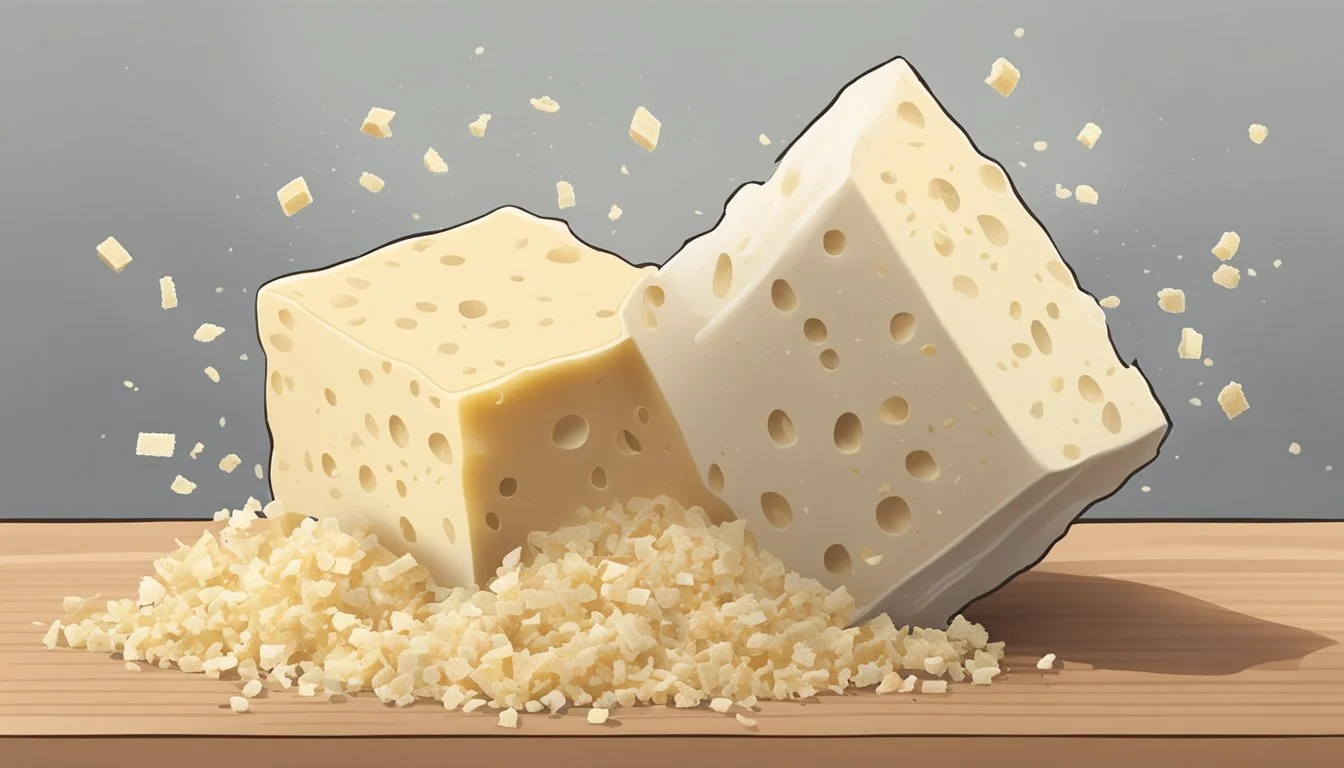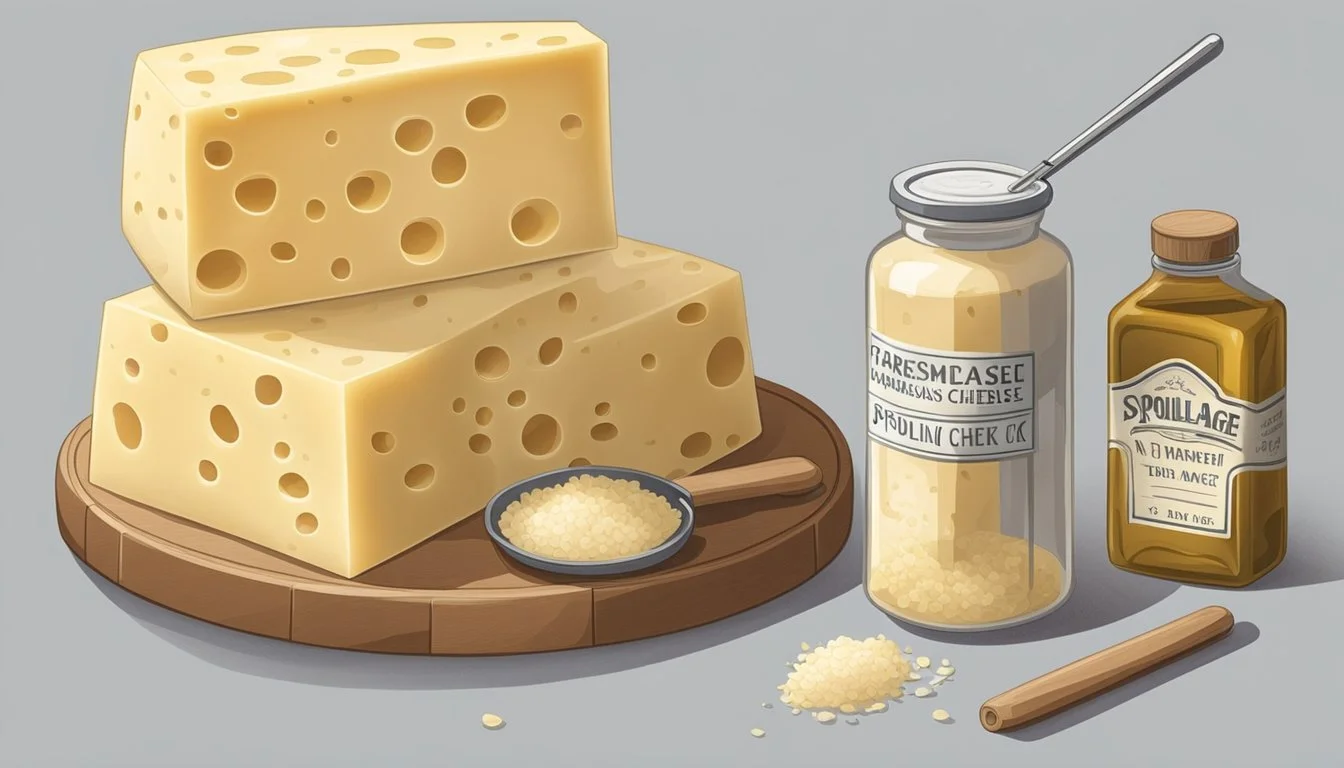How Long Does Parmesan Last?
Understanding Cheese Preservation
Parmesan cheese, known for its hard texture and sharp, nutty flavor, is a staple in many kitchens, revered both for its taste and its extended shelf life compared to softer cheeses. Its durability is largely due to the low moisture content and the aging process it undergoes, making it not just a flavorful addition to a multitude of dishes but also a practical choice for consumers seeking long-lasting dairy products.
Unopened and stored properly, Parmesan cheese can last between 7 to 9 months, maintaining its quality and flavor. Once opened, the cheese's longevity is influenced by its storage conditions, with an optimal shelf life of about 1 to 2 months in the refrigerator when kept in an airtight container to prevent moisture and other contaminants. The longevity of Parmesan cheese, as is the case with many perishable foods, is maximized when it is stored at consistent temperatures, specifically within the range of 40-45℉, as recommended for dairy preservation.
Understanding Parmesan Cheese
Parmesan cheese, particularly when referring to Parmigiano-Reggiano, is an iconic hard cheese with a rich tradition rooted in Italy. This section explores the various types and identifying qualities of Parmesan.
Types of Parmesan Cheese
Parmesan cheese can be categorized primarily by its age and the method of production. Parmigiano-Reggiano is a term protected by both Italian and European law to ensure it is produced using traditional methods from a specific region of Italy. It is aged for a minimum of 12 months, but some variants are aged for 24 months or longer, resulting in a more intense flavor. The types include:
Fresh Parmesan: Young cheese that has aged the minimum 12 months.
Aged Parmesan: Varieties that have been left to mature beyond the minimum time, often 24-36 months or more.
Characteristics of High-Quality Parmesan
High-quality Parmigiano-Reggiano exhibits specific characteristics that set it apart from other cheeses. Here are the distinctive traits:
Texture: A hard, gritty texture and a breakable, flaky quality.
Appearance: It should have a natural rind and a pale, golden hue without any signs of undesired mold.
Aroma: Genuine Parmigiano-Reggiano has a rich, savory aroma that intensifies with age.
Taste: The flavor profile should be nutty, with a balance of savory and slightly sharp notes.
The cheese is inspected rigorously to ensure a high standard of quality, bearing the signature pin dots that spell out Parmigiano-Reggiano to authenticate its origins and craftsmanship.
Storage Fundamentals
Proper storage techniques are crucial for maximizing the shelf life of Parmesan cheese. Understanding the ideal conditions and appropriate materials will ensure that the cheese maintains its flavor and texture for as long as possible.
Ideal Storage Conditions
The best way to store Parmesan cheese is in a refrigerator where it stays cool and dry. The optimal temperature range is between 39 to 46 degrees F (4 to 8 degrees C). Parmesan should be kept away from direct heat or sunlight, as consistent and moderate temperatures are essential to prevent spoilage. Humidity should also be minimized to discourage the growth of mold.
Packaging and Materials for Preservation
Parmesan cheese can be preserved best when wrapped in parchment paper followed by a layer of aluminum foil or placed inside an airtight container. These materials allow the cheese to breathe while keeping it free from excess moisture. Avoid using plastic wrap directly on the cheese, as it can promote condensation and mold growth. For grated Parmesan, a resealable plastic bag or a container with a tight-fitting lid is appropriate. When using cling wrap, ensure it's not the only layer of protection, and consider using cheese paper or wax paper first for better results.
Shelf Life and Freshness
The shelf life of Parmesan cheese varies significantly based on its form and storage conditions. Freshness can be determined through several indicators including color, texture, and aroma.
Shelf Life of Different Forms of Parmesan
Whole Parmesan Cheese: When properly stored at temperatures between 40-45℉, an unopened block of Parmesan can remain fresh for up to two years.
Grated Parmesan Cheese: Once grated, Parmesan cheese's shelf life reduces due to increased surface area and exposure to air. Grated Parmesan, when stored correctly, can last for about 7 to 9 months.
Storage Tips:
Keep whole blocks in the fridge, wrapped in parchment paper followed by aluminum foil to allow the cheese to breathe.
For grated Parmesan, an airtight container is essential to maintain freshness.
Indicators of Freshness
Color: Fresh Parmesan cheese typically has a pale, straw-like yellow color. Any discoloration could be a sign of spoilage.
Texture: It should feel hard and gritty to the touch. If the cheese feels slimy or excessively soft, it may not be fresh.
Aroma: Fresh Parmesan emits a nutty and slightly sharp odor which is characteristic of aged cheeses (What wine goes well with aged cheeses?). An off smell or an odor that resembles sour milk may indicate spoilage.
Mold: While small spots of mold can be cut away, extensive mold growth or mold that is not typical for the cheese (i.e., not white but black, pink, or green) suggests the cheese is no longer fresh and should not be consumed.
Properly assessing these factors ensures one enjoys Parmesan cheese in its optimal state of freshness and flavor.
Preventing and Identifying Spoilage
Proper storage of Parmesan cheese prevents spoilage and extends its shelf life, but it's still essential to recognize when the cheese is no longer good to consume. Understanding the signs of spoilage and how to prevent bacterial growth helps maintain the cheese's quality.
Signs of Spoilage
Mold Growth: Parmesan cheese may exhibit mold as fuzzy, green, blue, or black spots. The presence of mold indicates spoilage, as mold spores could have spread beyond visible areas.
Odor: An off or sour smell is a reliable indicator that Parmesan cheese has spoiled and should not be consumed.
To effectively identify mold growth and detect unusual odors, one should regularly inspect the cheese for any discoloration or smell changes, especially if the cheese has been stored for an extended period.
Preventing Bacteria Growth
Temperature: Store Parmesan within the fridge temperature range of 40-45℉ to slow down bacteria and mold development.
Hygiene: Use clean utensils when handling cheese to minimize contamination with bacteria.
Wrapping: Keep Parmesan wrapped in foil or tight-fitting packaging to protect it from air, which carries mold spores and bacteria.
By maintaining these conditions, one inhibits bacteria growth and keeps Parmesan from drying out prematurely, preserving both its flavor and texture.
Maximizing Parmesan's Lifespan
Proper storage and handling techniques are paramount in extending the shelf life of Parmesan cheese. Careful consideration of fridge temperature and protection against moisture can preserve Parmesan's quality and flavor.
Best Practices for Prolonging Parmesan's Shelf Life
To ensure Parmesan cheese maintains its quality over time, one should adhere to the appropriate storage methods. Cheese should be kept in the fridge at a temperature between 34°F and 40°F to slow down spoilage. Moisture is a major enemy of Parmesan's longevity; therefore, the cheese should be stored in a way that minimizes its exposure. It is beneficial to wrap Parmesan tightly in plastic wrap or aluminum foil, and then place it in an airtight container to keep it dry. Regular checks for any signs of spoilage, such as mold, odd smell, or color changes, should be conducted. Removing the cheese from its original packaging and rewrapping it after each use can greatly extend its shelf life.
Make your life easier by ordering plastic food wrap online, it's just a few clicks away!
When to Freeze Parmesan
Freezing Parmesan can be a viable option for extending its shelf life, especially if one has a large quantity or cannot consume it before it begins to spoil. When freezing, it is ideal to cut the cheese into small, manageable portions for ease of thawing later. If Parmesan is grated, it can be stored in a freezer-friendly container or bag. Freezer burn can be minimized by ensuring the cheese is wrapped tightly and with as little air as possible in the packaging. Parmesan can be frozen for several months. Thawing should be done in the refrigerator, and the cheese should be used within a day or two after thawing for best quality. Freezing can slightly alter the texture, but it should still be suitable for cooking and grating over dishes.
Using Aged Parmesan
Aged Parmesan, known for its rich flavor and versatility, finds its place in an array of culinary applications, magnifying taste and elevating the flavor profiles of various dishes.
Culinary Uses for Aged Parmesan
Chefs frequently utilize aged Parmesan for its distinct sharp, nutty flavor which intensifies depending on the duration of aging. It is an excellent cheese for grating over pasta dishes, ensuring a freshly grated enhancement directly before serving. Not only limited to pasta, but aged Parmesan also melds harmoniously into sauces, from classic Alfredo to a bold arrabbiata, where its flavor permeates to create a profound depth. Aged Parmesan offers a finishing touch to salads and soups, where it imparts a savory note that complements the other ingredients. Furthermore, it can be incorporated into casseroles for a delectable crust when baked.
Pairing and Enhancing Flavors
When it comes to pairing and enhancing flavors, aged Parmesan is exceptional. It boasts a complex flavor profile that transforms simple ingredients into gastronomic delights. The sharpness of aged Parmesan pairs perfectly with the acidity of tomatoes in pasta dishes, while its umami quality enriches the hearty feel of soups and casseroles. In a salad, the cheese’s robust taste balances well with vinaigrettes and fresh greens, infusing a burst of flavor with every bite. Additionally, it works as a flavor enhancer, adding a new dimension to the food without overpowering the original taste.
Post-Usage Tips
Managing Parmesan cheese after use is crucial for maintaining its freshness and discovering innovative ways to utilize every part of the cheese, such as the rind. Proper handling and storage of leftovers can prolong the life of the cheese, while rinds offer a depth of umami flavour to various dishes.
Handling Leftovers
After grating or cutting a wedge of Parmesan, leftovers should be stored carefully to retain their quality. It is essential to wrap the leftover Parmesan tightly in plastic wrap or place it in an airtight container. Store the cheese in the refrigerator's designated cheese drawer or coldest section to keep it fresh. Here is a simple guide for storing leftover Parmesan:
Whole wedges: Wrap in parchment paper, then a layer of plastic wrap.
Grated Parmesan: Store in an airtight container, and for extra freshness, a layer of plastic wrap can be placed directly on the surface before sealing.
Avoid the crowds and shop for parchment paper online from the comfort of your home!
Creative Uses for Parmesan Rinds
The rind of Parmesan is often discarded, but it has much to offer in terms of flavor. When simmering soups, stews, or stocks, adding a Parmesan rind can impart a rich, savory taste. The rind should be removed before serving. For a delicious snack, small pieces of rind can be toasted to create a crunchy treat. Below are some specific approaches to reusing Parmesan rinds:
Soup Enhancer: Simmer a rind in broths for at least 30 minutes.
Toasted Rind: Cut the rind into small pieces, bake until crispy, and enjoy.
By following these suggestions, you can ensure that every bit of Parmesan cheese is used effectively, minimizing waste while enriching the flavors of your culinary creations.
Comparing Parmesan to Other Cheeses
In the diverse world of cheeses, each type has characteristics that define its longevity and culinary uses. The following subsections provide a focused comparison between Parmesan and other categories of cheese, with specific emphasis on texture, taste, and shelf life.
Experience the convenience and savings of buying parmesan cheese online!
Parmesan Versus Soft Cheeses
Parmesan cheese stands distinct from soft cheeses such as mozzarella in several ways. It has a hard texture and a strong, savory flavor, while soft cheeses like mozzarella have a supple texture and a mild taste. This hard texture directly influences Parmesan's longer shelf life as compared to soft cheeses, which tend to spoil more quickly due to higher moisture content. A block of Parmesan, for example, can last several months when stored properly.
Texture: Parmesan (hard) vs. Mozzarella (soft)
Taste: Parmesan (savory) vs. Mozzarella (mild)
Shelf life: Parmesan (long) vs. Mozzarella (short)
Differentiating Parmesan and Other Hard Cheeses
While Parmesan is a hard cheese, it is not the only one in the category. Other hard cheeses, such as cheddar, may also enjoy a lengthy shelf life. However, Parmesan is typically aged longer than many other hard cheeses, up to 36 months, which intensifies its flavor and further reduces moisture, contributing to its longevity. Parmesan’s taste is more nutty and granular, contrasting with cheddar’s often creamier and sharper flavor profile.
Aging: Parmesan (up to 36 months) vs. Cheddar (varies)
Flavor: Parmesan (nutty, granular) vs. Cheddar (creamy, sharp)
Shelf life: Influenced by aging and moisture content
Through these comparisons, it is evident that Parmesan cheese distinguishes itself with a unique combination of aging, flavor, and durability.










